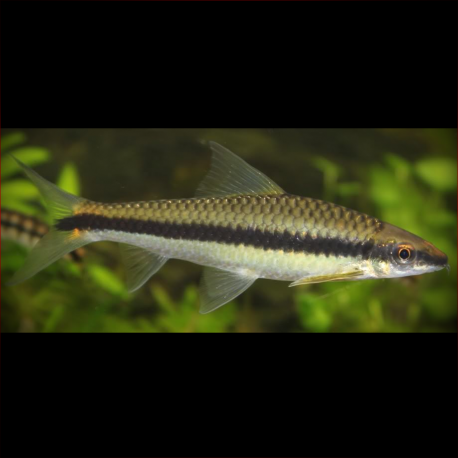More info
Datasheet
| Minimum Tank Size | 120 litres / 31.70 US gallons |
| Maximum Size | 7.5cm / 2.95inches |
| Temperature | 20°C / 68.00°F - 26°C / 78.80°F |
| Hardness | 1.01dgH / 18ppm - 15.02dgH / 268ppm |
| pH | 6.0-7.5 |
General Description
The Siamese Algae Eater, scientifically known as Crossocheilus Atrilimes, is a species within the Cyprinidae family and belongs to the order Cypriniformes. It is commonly traded under the names "Siamese algae-eater," "Siamese flying fox," and "Crossocheilus siamensis," though the latter is a synonym. This species displays a dark body stripe that can change in appearance during different moods and interactions with other fish. Differentiated from similar congeners, it is characterized by specific features such as the presence of a single pair of rostral barbels.
Aquarium Setup
For optimal compatibility and natural behavior, it is recommended to maintain Siamese Algae Eaters in groups of six or more in a tank resembling a flowing river or stream environment. The setup should include a substrate of rocks, gravel, and boulders, along with driftwood and root structures for hiding places. Hardy plant species like Microsorum, Bolbitis, or Anubias can be attached to the decor. Clean water with high oxygen levels and moderate water movement is essential, necessitating the use of external filters or powerheads.
Behaviour
Siamese Algae Eaters are generally peaceful but prefer to be kept in groups to prevent bullying within the shoal. They exhibit shoaling behavior and develop a pecking order amongst themselves. In captivity, these fish can display interesting interactions when maintained with other species that thrive in similar conditions. They are known to browse on algae, diatoms, and other microscopic organisms in their natural habitat.
Feeding and Diet
Siamese Algae Eaters are renowned for consuming black brush algae, making them popular choices for planted aquariums. In addition to algae, they can be fed high-quality dried foods with added Spirulina, along with fresh vegetable matter like peas, courgette, and spinach. The fish may ascend to the midwater level to feed and browse on biofilm that forms on rocks within the tank.
Reproduction & Dimorphism
Reproduction of Siamese Algae Eaters is not commonly observed in captivity, and young fish available in the trade are typically farm-raised with the use of hormones. Seasonal reproductive migrations are reported in the wild, where the fish move upstream during drier months and downstream when water levels rise. Sexual dimorphism is challenging to determine in young fish, but mature females tend to be thicker-bodied than males.
Habitat and Distribution
Siamese Algae Eaters inhabit flowing streams and tributaries with substrates of boulders, pebbles, gravel, and sand, often surrounded by submerged driftwood or tree roots. They are found in the Mekong and Chao Phraya drainages, spanning across Laos, Thailand, and Cambodia. Further studies are needed to understand the distribution of different species of laterally-striped Crossocheilus, particularly in Thailand, where populations may represent undescribed species.

